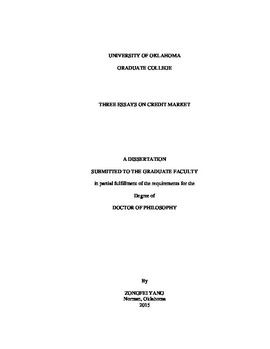| dc.contributor.advisor | Ederington, Louis | |
| dc.contributor.advisor | Pradeep, Yadav | |
| dc.contributor.author | Yang, Zongfei | |
| dc.date.accessioned | 2015-04-29T21:45:31Z | |
| dc.date.available | 2015-04-29T21:45:31Z | |
| dc.date.issued | 2015-05-08 | |
| dc.identifier.uri | https://hdl.handle.net/11244/14547 | |
| dc.description.abstract | My dissertation focuses primarily on credit markets from a corporate finance perspective, with a concentration on corporate bonds and security offerings. My dissertation consists of three essays. Essay One is titled “Underpricing of Corporate Bond Offerings: Evidence and Determinants”; Essay Two is titled “Calculating Abnormal Returns in Bond Market Event Studies”; and Essay Three is titled “Bond Market Reaction to Earnings Surprises and Post Earnings-Announcement Drift”. My research is partially motivated by the 2007/2008 financial crisis, which highlighted the importance of sound credit markets.
In recent years, the Federal Reserve policy has pushed base interest rates to record lows, which has helped fuel trillions of corporate-bond issuance activities. “Underpricing of Corporate Bond Offerings: Evidence and Determinants” examines whether and to what extent newly-issued corporate bonds are underpriced. The availability of the TRACE database, which contains comprehensive secondary market bond transaction prices, enables me to measure bond underpricing as the return from the offering price to the secondary market price immediately after the issue. This measure of underpricing is largely adopted by equity offerings literature. Whereas other recent studies find evidence of underpricing only for speculative grade bonds and/or initial public issues, I find significant underpricing for corporate bonds across all rating classes including investment grade bonds and seasoned offerings. My results raise questions concerning the efficiency of capital raising process in the bond market.
“Corporate Bond Market Event Study Methods” examines issues in the construction of corporate bond event studies using bond transaction data. Procedures used in studies to date have relatively low power to detect an event impacting bond prices. We show that this low power is largely due to the substantial heteroskedasticity in bond returns and infrequent trading. Focusing on handling these obstacles, we propose tests that yield considerably higher power.
The essay “Bond Market Post-Earnings-Announcement Drift” examines the bond market post-earnings announcement return patterns. While post-earnings announcement drifts (PEAD) is, as Fama put it, the granddaddy of all market anomalies in the equity market, whether PEAD exists in corporate bond market is understudied. We find evidence of bond market PEAD following especially positive earnings surprises, suggesting that negative information gets impounded into bond prices more efficiently than positive information. We further find that bond market PEAD appears to be driven by illiquidity, which we interpret as evidence that bond market efficiency is likely hampered by lack of liquidity. | en_US |
| dc.language | en_US | en_US |
| dc.subject | Finance, Corporate Bonds, Security Offerings, Earnings Announcement | en_US |
| dc.title | Three Essays on Credit Market | en_US |
| dc.contributor.committeeMember | Megginson, William | |
| dc.contributor.committeeMember | Fernando, Chitru | |
| dc.contributor.committeeMember | Linn, Scott | |
| dc.contributor.committeeMember | Thomas, Wayne | |
| dc.date.manuscript | 2015-03 | |
| dc.thesis.degree | Ph.D. | en_US |
| ou.group | Michael F. Price College of Business | en_US |
| shareok.nativefileaccess | restricted | en_US |
